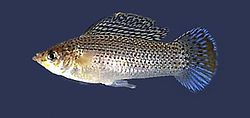Poecilia
| Poecilia | |
|---|---|

| |
| Male sailfin molly (P. latipinna) | |
| Scientific classification | |
| Kingdom: | |
| Phylum: | |
| Class: | |
| Order: | |
| Family: | |
| Genus: | Poecilia Bloch & J. G. Schneider, 1801
|
| Type species | |
| Poecilia vivipara Bloch & J. G. Schneider, 1801
| |
| Species | |
|
See text. | |
Poecilia is a genus of fishes in the family Poeciliidae of the order Cyprinodontiformes.[1] These livebearers are native to fresh, brackish and salt water in the Americas, and some species in the genus are euryhaline. A few have adapted to living in waters that contain high levels of toxic hydrogen sulfide (H
2S)[2] and a population of P. mexicana lives in caves (other populations of this species are surface-living).[3]
Some common and widespread species are often kept as aquarium fish, while other have very small ranges and are seriously threatened.[2] All species in Poecilia are called mollies except for the Endler's livebearer (P. wingei) and the well-known guppy (P. reticulata). Without a modifying adjective, molly usually refers to the species Poecilia sphenops.
Micropoecilia has been proposed to be included as a subgenus of Poecilia.[4]
Aquaria
Along with their platy relatives, the mollies are part of a pivotal aquaculture group of livebearers, which can live in water from fresh to fully marine, and a wide range of other conditions. They feed on smaller insects, animals, and vegetation.
IUCN lists two of the species, the sulphur molly, P. sulphuraria, and the broadspotted molly, P. latipunctata, as Critically Endangered.
The generic name Poecilia derives from the Greek ποικίλος (variegated), in reference to the fishes' coloration.
The common mollies (P. sphenops) occur in several different colors and spot patterns, such as black, white, black and white spots, orange, and orange and white spots. These have been kept successfully in freshwater, brackish, and saltwater conditions, although the last is not recommended for the novice aquarist. Mollies need to live in water at 25 to 28 °C (77 to 82 °F).[citation needed]
Species
The 40 currently recognized species in this genus are:[5][6]
- Poecilia boesemani Poeser, 2003
- Poecilia butleri D. S. Jordan, 1889 (Pacific molly)
- Poecilia catemaconis R. R. Miller, 1975 (Catemaco molly)
- Poecilia caucana (Steindachner, 1880) (Cauca molly)
- Poecilia caudofasciata (Regan, 1913)
- Poecilia chica R. R. Miller, 1975 (dwarf molly)
- Poecilia dauli M. K. Meyer & Radda, 2000
- Poecilia dominicensis (Evermann & H. W. Clark, 1906)
- Poecilia elegans (Trewavas, 1948) (elegant molly)
- Poecilia formosa (Girard, 1859) (Amazon molly)
- Poecilia gillii (Kner, 1863)
- Poecilia hispaniolana Rivas, 1978 (Hispaniola molly)
- Poecilia hondurensis Poeser, 2011
- Poecilia kempkesi Poeser, 2013[6]
- Poecilia koperi Poeser, 2003
- Poecilia kykesis Poeser, 2002
- Poecilia latipinna (Lesueur, 1821) (sailfin molly)
- Poecilia latipunctata Meek, 1904 (broadspotted molly)
- Poecilia marcellinoi Poeser, 1995
- Poecilia maylandi M. K. Meyer, 1983 (Balsas molly)
- Poecilia mechthildae M. K. Meyer, Etzel & Bork, 2002
- Poecilia mexicana Steindachner, 1863 (shortfin molly)
- Poecilia nicholsi (G. S. Myers, 1931)
- Poecilia obscura Schories, M. K. Meyer & Schartl, 2009
- Poecilia orri Fowler, 1943 (mangrove molly)
- Poecilia parae C. H. Eigenmann, 1894
- Poecilia petenensis Günther, 1866 (Peten molly)
- Poecilia reticulata W. K. H. Peters, 1859 (guppy)
- Poecilia rositae M. K. Meyer, K. Schneider, Radda, B. Wilde & Schartl, 2004[7]
- Poecilia salvatoris Regan, 1907 (Liberty molly)
- Poecilia sarrafae Bragança & W. J. E. M. Costa, 2011
- Poecilia sphenops Valenciennes, 1846 (black molly)
- Poecilia sulphuraria (Álvarez, 1948) (sulphur molly)
- Poecilia teresae D. W. Greenfield, 1990 (mountain molly)
- Poecilia vandepolli van Lidth de Jeude, 1887
- Poecilia velifera (Regan, 1914) (sailfin molly)
- Poecilia vivipara Bloch & J. G. Schneider, 1801
- Poecilia waiapi Bragança, W. J. E. M. Costa & Gama, 2012
- Poecilia wandae Poeser, 2003
- Poecilia wingei Poeser, Kempkes & Isbrücker, 2005 (Endler's livebearer)[8]
-
A male Dalmatian sailfin molly in a community aquarium
-
Black male molly
References
- ^ "Poecilia". Integrated Taxonomic Information System. Retrieved June 8, 2006.
- ^ a b Palacios, Arias-Rodriguez, Plath, Eifert, Lerp, Lamboj, Voelker, & Tobler (2013). The Rediscovery of a Long Described Species Reveals Additional Complexity in Speciation Patterns of Poeciliid Fishes in Sulfide Springs. PLoS ONE 8(8): e71069.
- ^ Plath; Heubel; García de León; & Schlupp (2005). Cave molly females (Poecilia mexicana, Poeciliidae, Teleostei) like well-fed males. Behav. Ecol. Sociobiol 58: 144–151.
- ^ Bragança, P. H. N. and W. J. E. M. Costa (2011): Poecilia sarrafae, a new poeciliid from the Paraíba and Mearim river basins, northeastern Brazil (Cyprinodontiformes: Cyprinodontoidei). Ichthyological Exploration of Freshwaters v. 21 (no. 4) [Dec. 2010]: 369–376.
- ^ Froese, Rainer; Pauly, Daniel (eds.). "Species in genus Poecilia". FishBase. February 2013 version.
- ^ a b Poeser, F.N. (2013): Apropos Guppys... viviparos, Das Lebendgebärenden Magazin, (11) 1: 36-40, 56. (In German)
- ^ Manfred K. Meyer, Alfred C. Radda, Manfred Schartl, Klaus Schneider & Brigitta Wilde (November 2004). "A new species of Poecilia, subgenus Mollienesia, from upper río Cahabón system, Guatemala, with remarks on the Nomenclature of Mollienesia petenensis Günther, 1866 (Teleostei: Cyprinodontiformes: Poeciliidae)" (PDF). Zoologische Abhandlungen. 54: 145–154. ISSN 0375-5231.
{{cite journal}}: CS1 maint: multiple names: authors list (link) - ^ Fred N. Poeser; Michael Kempkes; Isaac J. H. Isbrücker (2005). "Description of Poecilia (Acanthophacelus) wingei n. sp. from the Paria Peninsula, Venezuela, including notes on Acanthophacelus Eigenmann, 1907 and other subgenera of Poecilia Bloch and Schneider, 1801 (Teleostei, Cyprinodontiformes, Poecilidae)" (PDF). Contributions to Zoology. 74: 97–115.


